This blog has come to an end of its lifespan. It has been a fun ride and I'm grateful you came along.
Please look for your favorite Birding Is Fun contributors on their personal blogs...if they still have them...and on other social media like Facebook, Twitter, and Instagram.
Monday, June 22, 2015
Saturday, June 6, 2015
2015 Backyard Big Year Update--May
Posted by
birdchaser
First off a word about leaves. Leaves bring insects, and insects bring birds. That's good and as it should be. But they also kill my views of the larger neighborhood, putting the kibosh on scoping out migrants at a distance. That said, a Common Loon flying low over my near neighborhood on 12 May was a much needed tough Code 3 bird for the yard.
Over 30 warbler species stream through my county in May. But with lots of days with north winds, migration was very poor this year. I only managed to get 14 warbler species in my yard during the day, and an additional two species by nocturnal flight call on my overnight recordings. I still have a lot of overnight recordings to review, so there should be some more species on there. But to show how tough it was this year, I didn't get a single Black-throated Blue in the yard and only singles of Magnolia Warbler and Yellow-rumped Warbler! Crazy!
A highlight of the month was a Mourning Warbler singing in the side yard. My recording of the song was enough for the Mourning Warbler Song Mapper program to identify it as coming from the Nova Scotia song dialect population. Very cool! (song here)
I'm still expecting to add more species to my overall year list as I go through my overnight recordings--I've already picked up some shorebirds including Least Sandpiper, Solitary Sandpiper, and Spotted Sandpiper. I'm pretty sure I've got a rare (Code 5) Short-billed Dowitcher recording or two I need to double check before claiming. So there is more to come.
Meanwhile, as it stands, my 2015 Backyard Big Year List stands at 138 species. June is expected to be slow, but I'll still be out trying to get my 20 Bird Minimum Daily Requirement and see if I can add a few more species to the list before the southbound migrants start showing up again in late June/early July.
More May highlights and photos at the Backyard Big Year Blog.
Friday, June 5, 2015
A Kirtland's Warbler Among Chicago Migrants
Posted by
Julie G.
Migration in Chicago is always interesting and exciting. So far, the highlight of the 2015 spring season has been the arrival of a male Kirtland's Warbler at Montrose Point Bird Sanctuary. This rare bird stayed for two days to the delight of birders and photographers. The Chicago Tribune Newspaper even published an article about the resplendent bird. After a quiet early May, things really picked up and colorful warblers, tanagers, vireos and cuckoos have been ever-present for a couple of weeks. Below I feature several of the beautiful birds I have spotted over the spring migration period.
An endangered Kirtland's Warbler surprises us with his glorious presence
A handsome male Hooded Warbler forages on the ground of the bird sanctuary
A pretty Golden-winged Warbler seeks nutrition amid the blossoms
A male Indigo Bunting shows off his vibrant plumage
Searching for a meal ~ Canada Warbler
Always a radiant sight ~ Prothonotary Warbler
A beautiful Yellow Warbler finds success on its food quest
Seeking insects in the budding trees ~ Magnolia Warbler
A handsome American Redstart is framed by the lush, green leaves
Getting ready for a bite to eat ~ A Blue-winged Warbler
A Black-billed Cuckoo sits quietly on its perch
Surrounded by spring growth ~ Palm Warbler
A brilliant orange Baltimore Oriole rests on a branch
A lovely Blackburnian Warbler explores the oak tree leaves for food
A rare sighting in Chicago ~ Western Kingbird
Posted by Julie Gidwitz
Nature's Splendor ~ http://naturessplendor-julie.blogspot.com/
Wednesday, June 3, 2015
Birding Bliss
Posted by
Kenneth Cole Schneider
A favorite birding site near our NE Illinois home is the 175 acre Bliss Woods Forest Preserve in Sugar Grove.
A bike trail connects Bliss woods with the 402 acre Hannaford
Woods-Nickels Farm Forest Preserve, forming a complex known as the
Bliss Woods-Waubonsee College open space assemblage. This protects a
varied habitat including hardwood forest, open prairies and wetlands.
Most of this section of Illinois is flat land, planted in miles and
miles of corn and soybeans, but thanks to preservation of the remnants
of the Kaneville Esker, this preserve is a green gem, with rolling hills
and valleys. Ridges (eskers) and prominent mounds (kames) interrupt the
monotony of the prairie. These features, as well as prairie potholes
(also known as kettles), were produced about 13,000 years ago by
retreating glaciers. Many have been disturbed or removed, as they are a convenient source of gravel.
Blackberry Creek as it courses through Bliss Woods:

Woodland path in Hannford Woods:
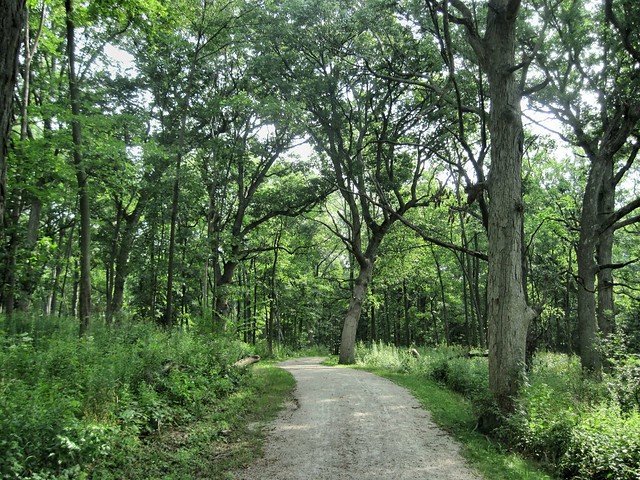
This barn, surrounded by a white rail fence, is on private property just across from the entrance to Hannaford Woods:
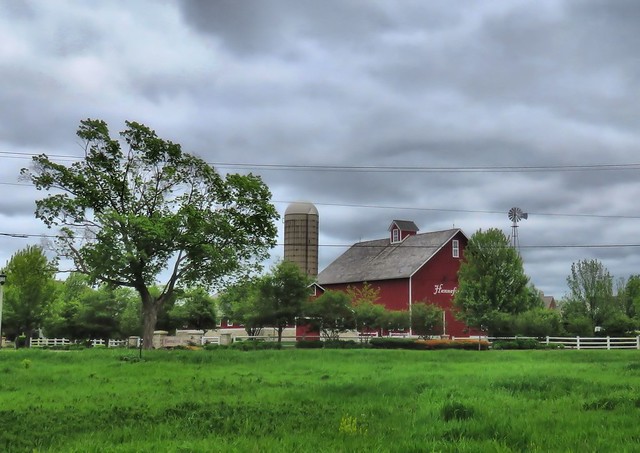
We visited the preserves several times before returning to Florida on May 24. On the first visit to Bliss Woods we obtained only distant views of a Scarlet Tanager, one of our favorite birds. Two days before returning to Florida we tried one last time. The morning started out windy and quite chilly at 46 degrees F (7.8 degrees Celsius). The tree limbs were moving so much that we held little hope of seeing many birds at all. Some of those which took flight actually flew backwards!
A male Northern Flicker was not affected by the wind as he searched for ants on the mowed lawn in the picnic area:
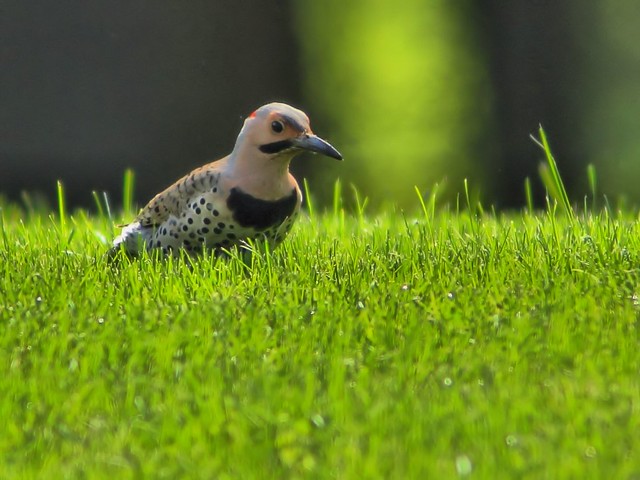
The winds subsided and the skies brightened, though the temperature dropped a couple of degrees. Yellow Warblers were already gathering nesting materials. This one sang in a small tree on its territory:

American Goldfinches bounded about, carefree, as they will not breed until later in the season:
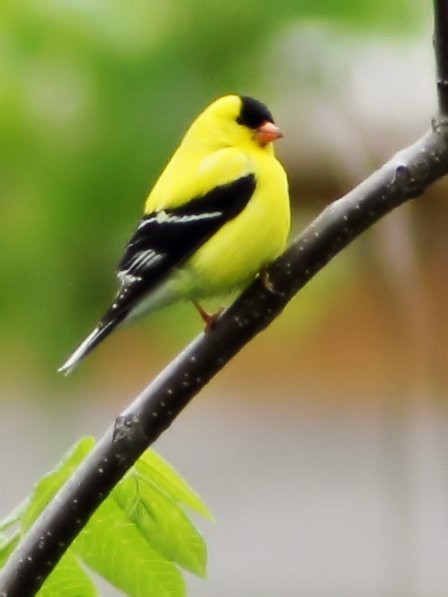
Indigo Buntings had arrived en masse:
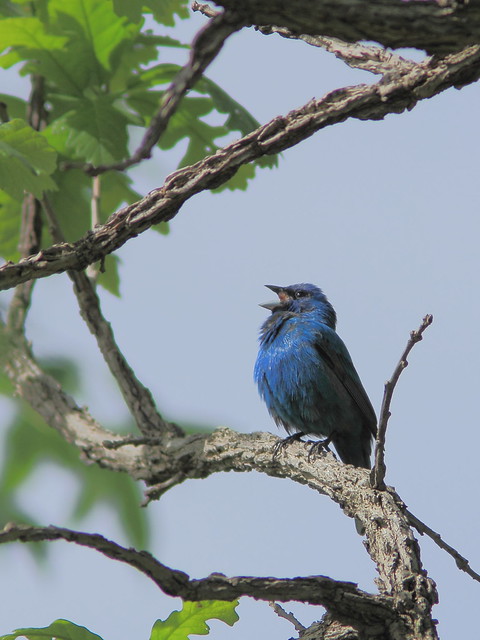
A White-breasted Nuthatch seemed to be exploring a nest hole. It kept poking its head in but never entered. I wondered if it might be occupied by another creature such as a squirrel or chipmunk:
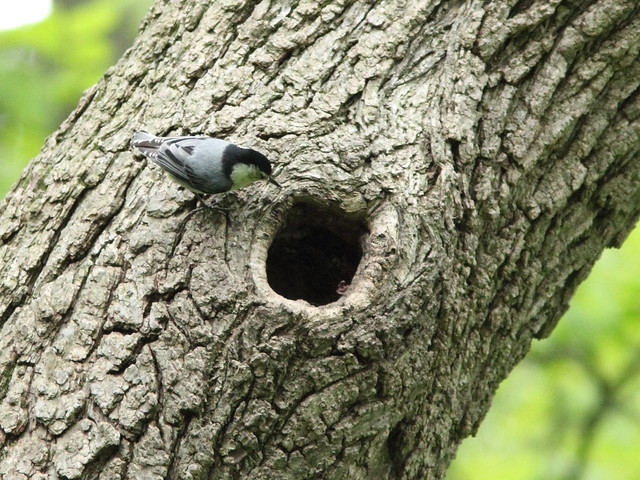
High in a nearby oak tree, I spotted a White-breasted Nuthatch fledgling:

As a parent approached with a grub, it started begging silently:

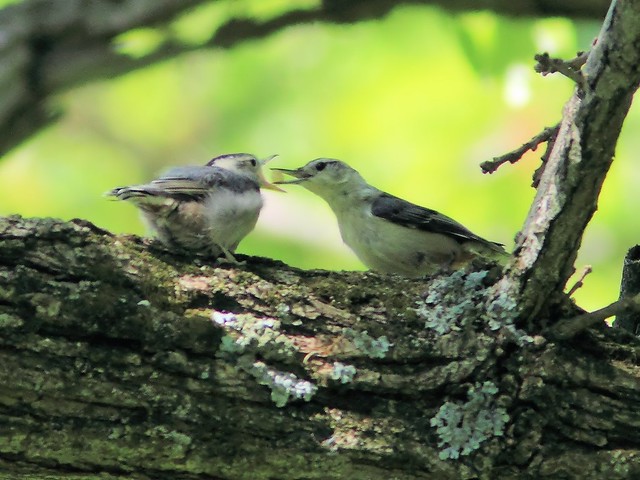
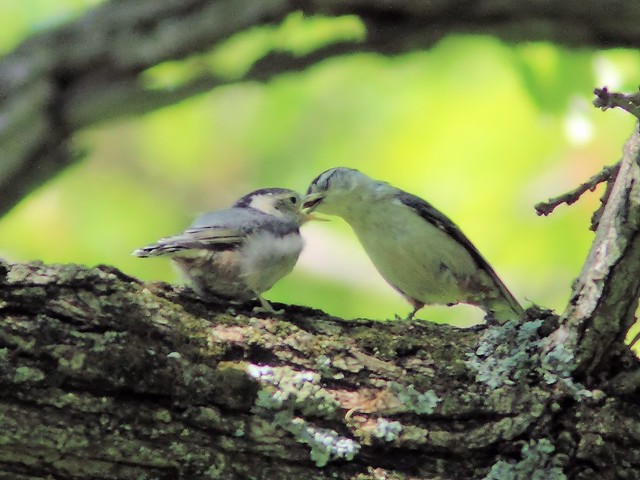
"I still want more!"
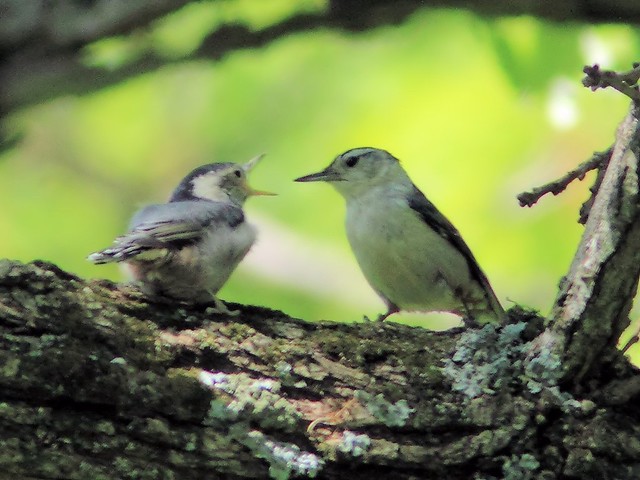
This first year male Orchard Oriole was the second we saw this week:
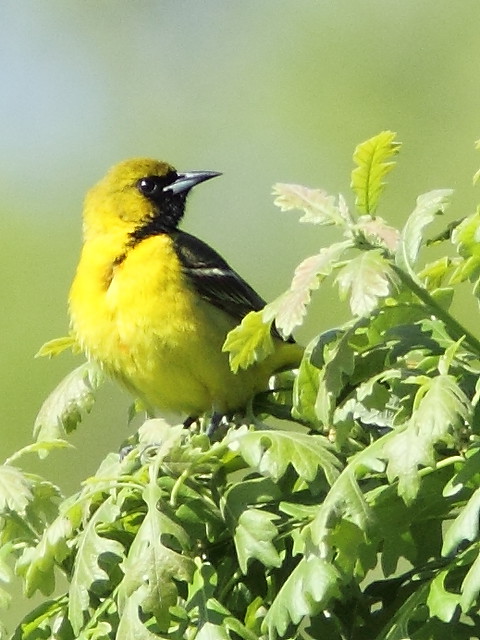
A male Orchard Oriole in full breeding plumage flew by but I was unable to get a photo, so here is one from May 14 a year ago. It is smaller than a Baltimore Oriole and has brick-red plumage rather than bright orange of the latter species:

A Red-tailed Hawk swooped in low. Not a threat to small birds, it was probably hoping to surprise a rabbit or squirrel:
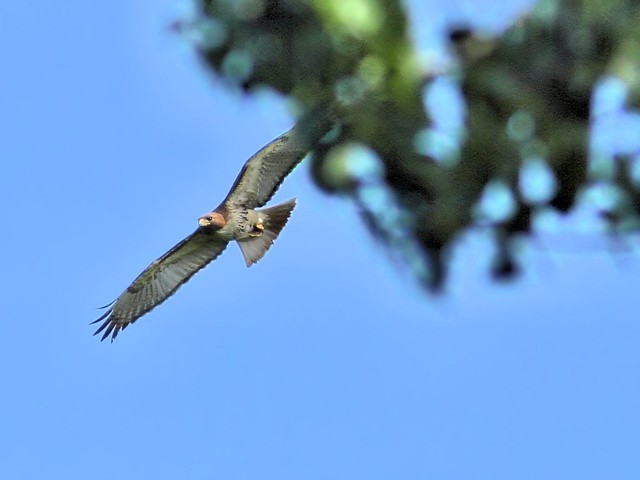
We have been watching a pair of Blue-gray Gnatcatcher build a nest which straddles a low-hanging limb of an old oak. Now the bird is sitting tight, surely incubating its eggs. We were pleasantly surprised to see that the fragile-looking nest had not been disrupted by the high winds and rain:

Finally, we were rewarded when a male Scarlet Tanager suddenly flew into full sun in a tree just above the trail:
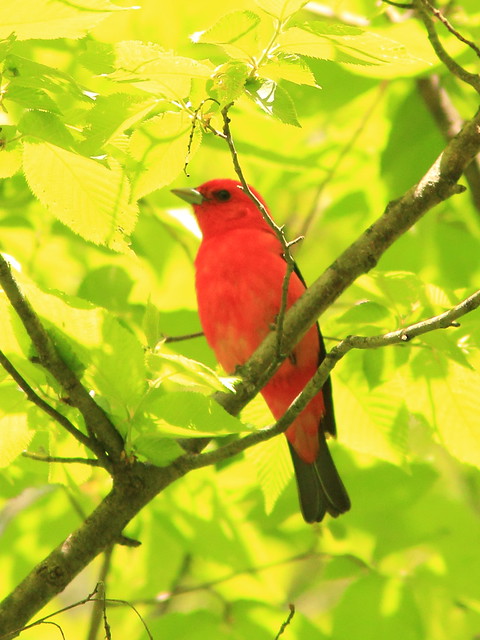
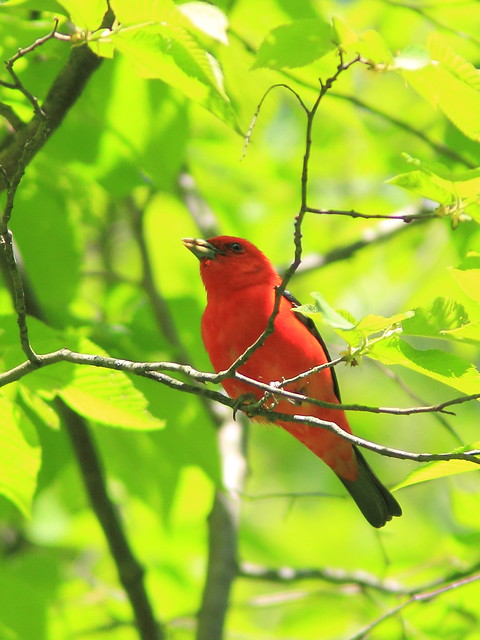
His coat is deeply scarlet except for black wings and tail. The sun was high and the leaves cast strong dappled shadows. Nearly all of my dozen photos were spoiled because of the sharp contrasting patches of light. This one better illustrates the problem, as the red color (and the green on the leaves) is washed out in the highlights:
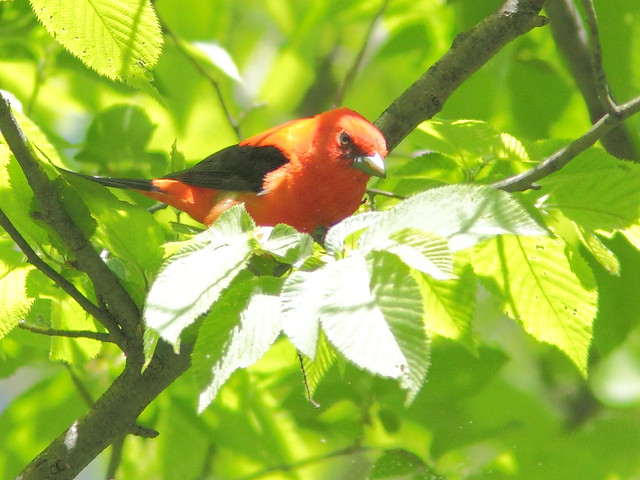
Speaking of highlights, my final visit to Hannaford Woods produced a Life Bird! This does not happen very often these days, as I have lost interest in chasing after target birds. While walking the trail I heard a very loud warbler song coming from close to the ground nearby. I simply could not identify the song and tried to find the bird for the better part of half an hour. The understory was so dense and it was so tantalizingly close by!
Before continuing down the trail, I recorded the song on my iPhone, hoping to research it and identify the singer. On the way back I replayed the song and the bird responded immediately. I caught a glimpse of it, singing a few inches off the ground. It had a brown back and a distinct eye ring, but it flew off in less than a second. It continued to sing in the distance, but to my surprise a second bird appeared and sat still long enough for me to capture a 25 second burst of images before it flew off. My photos confirmed that it was a Connecticut Warbler, the first I had ever seen, and the first County record this spring.
This seclusive but not rare warbler breeds in the far north Central US and central Canada. Despite its name it is rarely found in the NE United States, and then only in the fall. The few winter records are from South and Central America.
Connecticut Warbler (May 19, 2015):

Another "first" occurred early in our stay. I was looking for a Sora in Jones Meadow Park, a small wetlands near our home. Sure enough, I saw two Soras and heard one or two others:
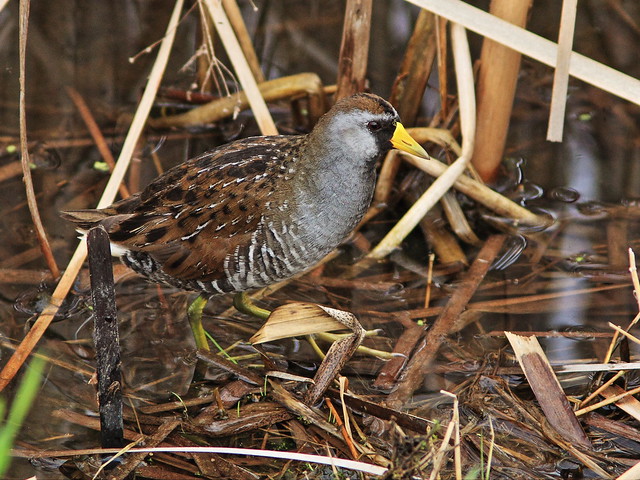
Then, a Virginia Rail started calling and suddenly strutted out at the edge of the marsh:
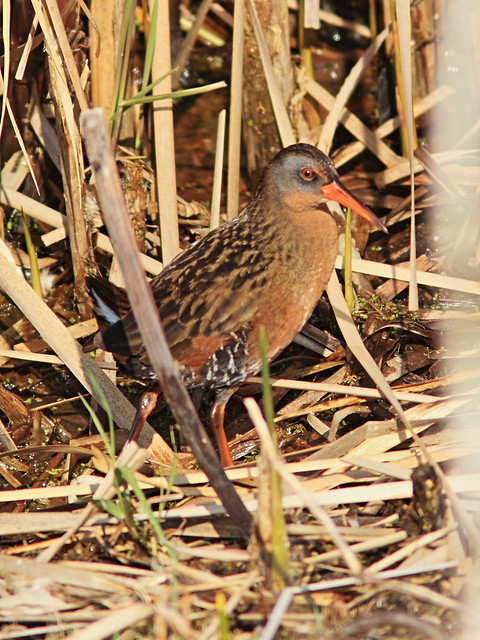
A damselfly, which I believe to be a female bluet species, allowed me a close-up shot:
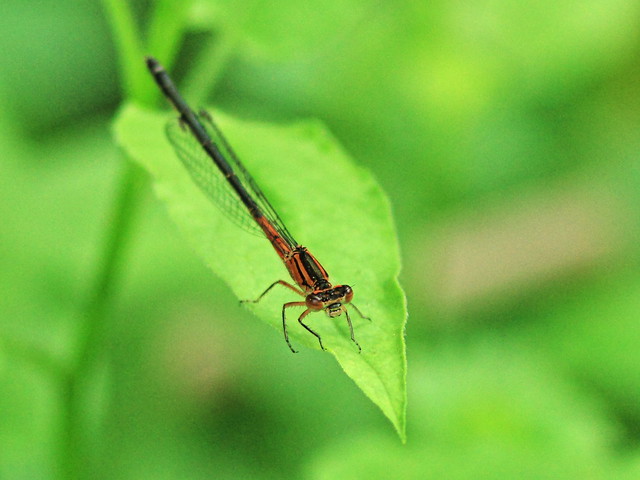
Blackberry Creek as it courses through Bliss Woods:

Woodland path in Hannford Woods:

This barn, surrounded by a white rail fence, is on private property just across from the entrance to Hannaford Woods:

We visited the preserves several times before returning to Florida on May 24. On the first visit to Bliss Woods we obtained only distant views of a Scarlet Tanager, one of our favorite birds. Two days before returning to Florida we tried one last time. The morning started out windy and quite chilly at 46 degrees F (7.8 degrees Celsius). The tree limbs were moving so much that we held little hope of seeing many birds at all. Some of those which took flight actually flew backwards!
A male Northern Flicker was not affected by the wind as he searched for ants on the mowed lawn in the picnic area:

The winds subsided and the skies brightened, though the temperature dropped a couple of degrees. Yellow Warblers were already gathering nesting materials. This one sang in a small tree on its territory:

American Goldfinches bounded about, carefree, as they will not breed until later in the season:

Indigo Buntings had arrived en masse:

A White-breasted Nuthatch seemed to be exploring a nest hole. It kept poking its head in but never entered. I wondered if it might be occupied by another creature such as a squirrel or chipmunk:

High in a nearby oak tree, I spotted a White-breasted Nuthatch fledgling:

As a parent approached with a grub, it started begging silently:



"I still want more!"

This first year male Orchard Oriole was the second we saw this week:

A male Orchard Oriole in full breeding plumage flew by but I was unable to get a photo, so here is one from May 14 a year ago. It is smaller than a Baltimore Oriole and has brick-red plumage rather than bright orange of the latter species:

A Red-tailed Hawk swooped in low. Not a threat to small birds, it was probably hoping to surprise a rabbit or squirrel:

We have been watching a pair of Blue-gray Gnatcatcher build a nest which straddles a low-hanging limb of an old oak. Now the bird is sitting tight, surely incubating its eggs. We were pleasantly surprised to see that the fragile-looking nest had not been disrupted by the high winds and rain:

Finally, we were rewarded when a male Scarlet Tanager suddenly flew into full sun in a tree just above the trail:


His coat is deeply scarlet except for black wings and tail. The sun was high and the leaves cast strong dappled shadows. Nearly all of my dozen photos were spoiled because of the sharp contrasting patches of light. This one better illustrates the problem, as the red color (and the green on the leaves) is washed out in the highlights:

Speaking of highlights, my final visit to Hannaford Woods produced a Life Bird! This does not happen very often these days, as I have lost interest in chasing after target birds. While walking the trail I heard a very loud warbler song coming from close to the ground nearby. I simply could not identify the song and tried to find the bird for the better part of half an hour. The understory was so dense and it was so tantalizingly close by!
Before continuing down the trail, I recorded the song on my iPhone, hoping to research it and identify the singer. On the way back I replayed the song and the bird responded immediately. I caught a glimpse of it, singing a few inches off the ground. It had a brown back and a distinct eye ring, but it flew off in less than a second. It continued to sing in the distance, but to my surprise a second bird appeared and sat still long enough for me to capture a 25 second burst of images before it flew off. My photos confirmed that it was a Connecticut Warbler, the first I had ever seen, and the first County record this spring.
This seclusive but not rare warbler breeds in the far north Central US and central Canada. Despite its name it is rarely found in the NE United States, and then only in the fall. The few winter records are from South and Central America.
Connecticut Warbler (May 19, 2015):

Another "first" occurred early in our stay. I was looking for a Sora in Jones Meadow Park, a small wetlands near our home. Sure enough, I saw two Soras and heard one or two others:

Then, a Virginia Rail started calling and suddenly strutted out at the edge of the marsh:

A damselfly, which I believe to be a female bluet species, allowed me a close-up shot:

Subscribe to:
Posts (Atom)

















